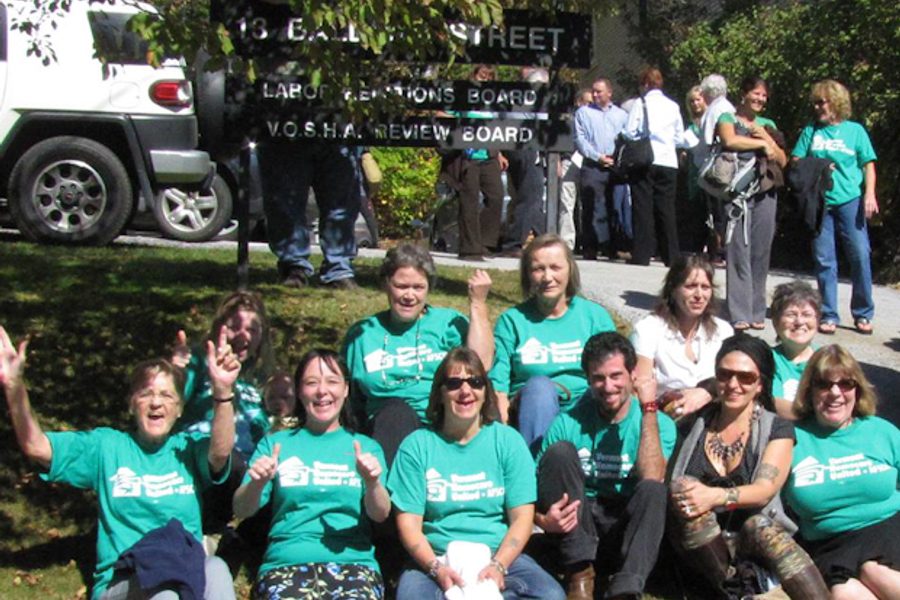
Last year, Heather Boyd was working as a part-time personal care assistant for her young autistic nephew in the home they shared in Shelburne, Vermont when Carolyn Klinglesmith knocked on her door.
Klinglesmith, an organizer for the American Federation of State, County and Municipal Employees (AFSCME), had been going door-to-door to promote the Vermont Homecare United, a newly launched statewide local union in AFSCME that sought rights for Vermont’s thousands of in-home care providers, including Boyd herself.
“As [Klinglesmith] explained how they were organizing to get better working conditions, a living wage, and representation, I was thrilled,” said Boyd. She joined VHU almost immediately and soon became an organizer herself.
In early October, she helped 7,500 fellow home care workers to win the largest union election victory in the state’s history — not to mention the largest nationally this year.
Boyd’s familiarity with AFSCME helped convince her of the importance of organizing for home care workers. Before she and her young child moved in with Boyd’s sister to care for her developmentally disabled nephew, Boyd had worked in an AFSCME-organized non-profit agency.
“Part of the reason I jumped on the AFSCME bandwagon so fervently is that I had firsthand experience with what a union does,” she said. “It saved my job.”
When a client accused Boyd of unethical behavior — with no justification, Boyd says — the local union president accompanied her to an interview with the agency’s human resources director. Boyd believes that union involvement guaranteed that her side of the story was heard, thus permitting the establishment of an arrangement to avoid future contact between Boyd and the client and allowing Boyd to remain employed.
Even home care workers without such a history saw value in having a union: the October 3 tally of the mail-in ballots from the 26 percent of workers participating in the election gave AFSCME 71 percent approval.
More than 2 million people are now employed nationwide as care assistants, providing personal in-home help for people with some degree of disability. In 2010, their median wage was $9.70 an hour; 37 percent have no health insurance. Though many personal care assistants, about half of whom are Latina or African-American women, work directly for the individuals who need care, they’re paid through Medicaid or Medicare. Thus, the government typically regards them as independent contractors, who are not eligible to form a union. This classification, in addition to the disparate nature of home care workplaces, has made organizing difficult in the past.
But when legislation at the state or local level recognizes them as “employees,” sometimes by creating a public employer, home care workers can — and do — join unions. As one of the fastest growing parts of the labor movement, they have mainly affiliated with the Service Employees (with about 500,000 home care worker members nationwide) and AFSCME (with 125,000).
Such has been the case in Vermont. After Democrats took control of the state governor’s office and retained the majority in the legislature in 2010, AFSCME organizers looked for political allies in the state — among them, the now-15-year-old Vermont Workers’ Center (VWC) and the grassroots organizing coalition it initiated, Put People First.
VWC Executive Director James Haslam said in an interview that one of his top priorities when AFSCME began organizing was to help link the union with community groups, especially two state-wide organizations of disabled people, “to make sure [organization] was a ‘win-win’” for caregivers and recipients. AFSCME agreed, he said.
In light of those considerations, the coalition proposed a law that made the state the employer but retained the right of the person receiving care to hire and fire the caregiver in addition to directing the care. The Vermont legislature passed a version of the bill in May of this year.
Calling Vermont’s vote to allow home care workers to unionize “a great victory,” AFSCME organizing director Mike Sukal said that the union would keep looking for places where it was politically possible to get around the barriers to organizing workers defined as independent contractors. AFSCME would not only continue its current organizing, he said, but also expand to include taxi drivers and medical interpreters.
For his part, Haslam hopes that the organizing activity will strengthen the labor movement and spur more organizing in Vermont. Already, the American Federation of Teachers has announced plans to organize Vermont teachers who work in homes.
Meanwhile, in light of home care workers’ recent decision to unionize with AFSCME, Klinglesmith continues her on-the-ground organizing in Vermont. Her new objective will be to involve as many home care workers as possible in planning for a first contract. “The more participants, the stronger the contract will be,” she said — and the stronger the contract is, the easier it will be to sign up more members in turn.
And what does Heather Boyd want? “I’d like to see an immediate pay increase [from her current $9.78 an hour]. And I’d like to see improved working conditions and training,” she tells In These Times. Health care? “I’m a realist,” she replies, “but it is on my list of concerns.” Now, at least, she has a union to do something about those concerns.
AFSCME is a website sponsor of In These Times.
David Moberg, a former senior editor of In These Times, was on staff with the magazine from when it began publishing in 1976 until his passing in July 2022. Before joining In These Times, he completed his work for a Ph.D. in anthropology at the University of Chicago and worked for Newsweek. He received fellowships from the John D. and Catherine T. MacArthur Foundation and the Nation Institute for research on the new global economy.








